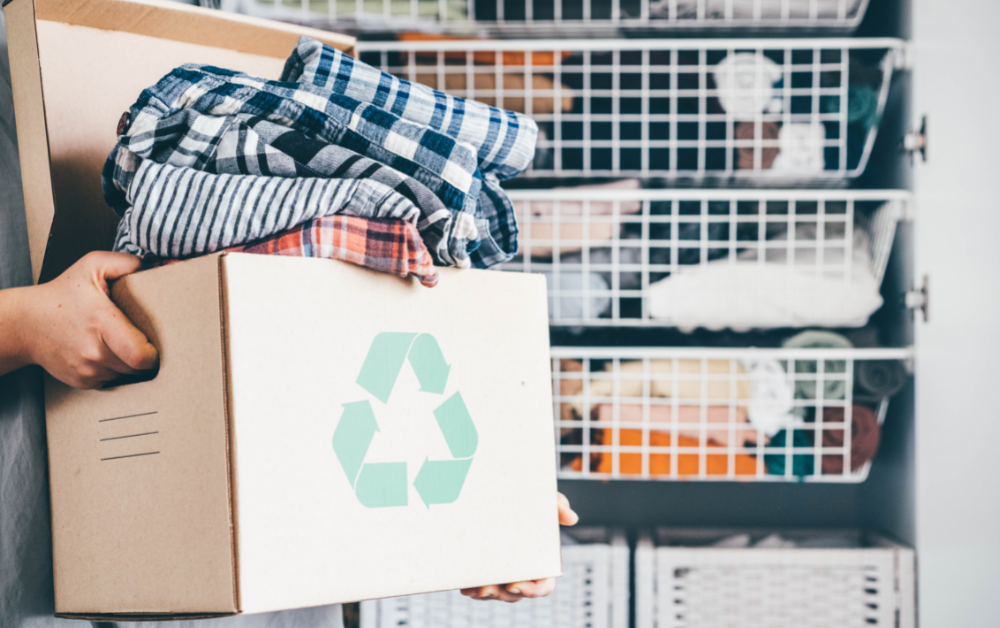Recycling Guide
by ajones | Oct 13, 2021 | Sustainability, Recycling, Blog | No Comments

The fashion industry is notorious for the waste it generates, particularly the fast fashion market. However, of the 86% of post-consumer textiles that could be diverted from landfills, 35% is “readily recyclable,” and 45% is “potentially recyclable” (Chua, 2020). Knowing when, where, and how to recycle textiles empowers consumers to dispose of apparel in a sustainable manner.
Definitions: recycling, upcycling, downcycling
The term recycling has become a common word in society’s vocabulary. Recycling is taking something that will be disposed of and changing it into something else that can still be used. While similar, terms like upcycling and downcycling are not as well known.
According to EthicalFashion.Online (n.d.), downcycling is breaking down materials to reuse them for another purpose, creating something useful but of lesser quality, such as a rag to use for cleaning. On the other hand, upcycling reuses items in a way that increases their value, extending a material’s life and often its desirability. Upcycled items are unique and do not require any further use of natural resources. An example would be creating a dress out of old jeans.
Recycling trends for textiles
Brands and retailers are embracing the need for recycling. The Renewal Workshop, which partners with clothing and textile brands to find circular solutions, released an impact report in 2020 based on data assessing more than 50 leading companies in the industry (Nishimura, 2020). Their findings included:
- Over 82% of textile waste can be revived and resold at a good margin.
- 46% of products collected in the past four years required only minor repairs to return them to store quality.
- Clothes are often discarded because of flaws or imperfections that include dirt and stains (26%), holes (21%), tears (9%), and broken zippers (more than 7%).
- Right now 24% of products found unfit for sale are sent to landfills or incinerated, and 5% are destroyed in another way.
- While 31% of fashion waste gets donated, only 8% is recycled or upcycled.
The growing popularity of secondhand companies, like ThredUp, demonstrate the large market for recycling today. A number of companies are incentivizing through brand exchange programs. For example, North Face lets customers drop off older items in exchange for some credit toward new purchases. H&M customers can drop off worn-out apparel; the company’s Garment Collecting program resells items, reuses them as materials for a new collection, or makes it into insulation material. Patagonia, Nike, Zara, Levi’s, Madewell, and Girlfriend Collective offer similar programs (Team ThredUp, 2020).
The sustainability benefits of recycling
Textile recycling offers numerous benefits for the fashion industry and the environment. Recycling decreases the need for landfill space, as fibers take years to decompose, if at all. Also, they can release methane and nitrous oxide as they decompose. On top of these harmful greenhouse gases, when it rains, water absorbs toxic materials in landfills, including chemicals, dyes, and bleaches commonly used in textiles. Therefore, extending an item’s lifecycle results in lower greenhouse gas creation and less risk to surrounding groundwater (Fibre2Fashion, 2014). Of course recycling clothes can help those who do not have the means to purchase new items, and it also supports emerging markets, such as increasingly popular secondhand retailers.
Recycling tips
Everyone can make a difference. Consumers should learn the various routes they can take when they are done using apparel or home textiles. Suggestions for proper recycling include:
- Donate textiles, but be careful that items are clean and dry. Mend and repair all holes before donating or reselling. Also remove pet hair, fuzz, and lint from fabric.
- Build a capsule wardrobe, maintaining a “buy less, wear more” mentality to avoid unneeded and unwanted purchases.
- Learn from never-worn items; avoid such purchases in the future.
- Repurpose apparel–endless options include cleaning cloths, a quilt top of old shirts, masks, etc.
- Share clothing with others; a rarely-worn shirt might complement a friend or family member’s style.
- Compost natural fiber items after removing non-compostable elements, such as zippers or buttons.
- Recycle by checking out programs like Terracycle, American Textile Recycling Service, and Green Tree. A number of nonprofit organizations also make donating clothes easy. These include the American Red Cross, Dress for Success, Soles4Soles, One Warm Coat, and Room to Grow. Many communities also facilitate local aid through churches, shelters, schools, and outreach centers.
The organization Accelerating Circularity estimates that there is a $350 billion market opportunity for recycled products, particularly in categories such as denim, home textiles, and activewear (Chua, 2020). There are countless sustainable opportunities ahead for both companies and consumers as they commit to recycling and supporting the circular economy for the benefit of the environment and society.
References
Chua, J. M. (2020, October 16). Textile recycling provides $350B opportunity in western hemisphere: Report. Sourcing Journal. https://sourcingjournal.com/topics/sustainability/accelerating-circulaty-lenzing-nike-textile-recycling-cotton-polyester-elastane-237744/
Ethical Fashion. (n.d.) What is the difference between upcycling and downcycling? EthicalFashion.Online. https://ethicalfashion.online/news-views/difference-between-upcycling-and-downcycling
Fibre2Fashion. (2014, February). Textile recycling: A step towards sustainability. Fibre2Fashion.com. https://www.fibre2fashion.com/industry-article/7254/textile-recycling–a-step-towards-sustainability
Nishimura, K. (2020, October 6). How much clothing gets recycled? just 8%, data shows. Sourcing Journal. https://sourcingjournal.com/topics/sustainability/the-renewal-workshop-apparel-recycling-textile-waste-upcycling-235768/
Team ThredUp. (2020, August 12). Skip landfill: 7 ways to upcycle your totally worn-out clothes. ThredUp. https://www.thredup.com/bg/p/how-to-upcycle-your-damaged-clothes?tswc_redir=true

Textile Recycling
Textile waste continues to be a growing problem. This is caused by the popularity of fast fashion, ...

Innovation and sustainability trends in apparel for 2021
Undoubtedly 2021 shows the continued need for all fashion stakeholders–brands, retailers, and...
-1-1.png)
Key Consumer Spending Trends For 2023
Consumers are the key to making sustainable investments through their purchase decisions. However,...
